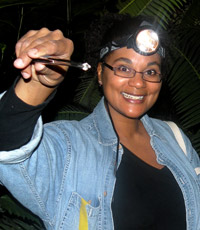


Listen to audio highlights from this interview. 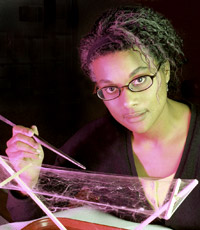
Andrade will gladly put up with "spider woman" jokes for the sake of getting people, particularly kids, interested in science. 
Born in Kingston, Jamaica, she moved to British Columbia when she was three years old, around the time she got this swank school lunch box. 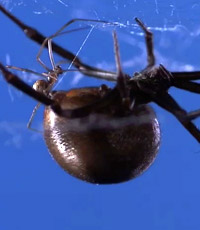
Like their cousins, North America's black widow spiders, Australian redbacks are sexually dimorphic. Females dwarf their mates. 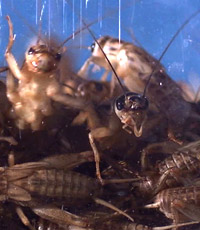
To see whether students have the stomach to work in her lab, Andrade puts them to what she calls "the cricket test." Find out more in this video. 
Andrade was a jock as a teen. Today, she compares doing biology fieldwork to playing sports—full of pain and hard work, yet immensely rewarding. 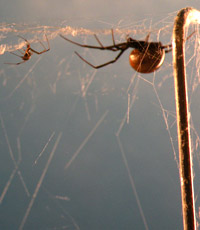
Among Australian redbacks, the rare male who can make his way to a female's web will likely end up as her meal. |
Poisonous spiders, sexual cannibalism, adaptive suicide—biologist Maydianne Andrade jokes that her research makes for good cocktail party conversations. It all seems slightly lurid and tends to intrigue even people who think they aren't interested in science. Yet what Andrade studies, at the core, are striking cases in evolution. In this interview, Andrade talks about spending months on end in the Australian outback peering into the nocturnal lives of redback spiders (one of about 20 species in the "black widow" genus, Latrodectus), what it's like to raise thousands of tiny spiderlings in her lab at the University of Toronto, and more. Fear notNOVA: Were you afraid of spiders when you were a kid? Maydianne Andrade: I was afraid of spiders. When I was really young, my two brothers and I were in the basement watching TV, and a fairly small—and, I realize now, completely harmless—spider crawled out into the middle of the living room floor, and we were terrified. We covered it up with a bowl. We were terrified to the point where we were actually standing on the couch. Q: What did you finally do? Andrade: We decided the safest thing was to vacuum the spider up. Q: Any other childhood bug memories? Andrade: I remember one instance when, as a family, we visited Jamaica. My parents, having grown up in Jamaica—in the country, mostly—were quite handy at grabbing insects, and my dad caught a really large katydid, which is like a big grasshopper. It was a beautiful, beautiful thing, and he said, "Do you want to try holding it?" I was about eight years old. I did hold it, but then it jumped away and left its legs behind in my hand. It took me a couple of years to get over that—I was more afraid of hurting insects than of them hurting me. Q: Do you think most people are afraid of spiders? Andrade: When I talk to school groups about spiders, at about the kindergarten level everyone's fine with them. Boys like them, girls like them; they think they're interesting. But by grade two or three, people start developing phobias or fears. I think they tune into the fact that their parents are afraid of them. Q: So do you feel that you have to defend spiders? Andrade: Well, when I talk to school groups and have my students talk to them, we're trying to dispel the idea that spiders are terrible. They're really an important part of our ecosystem. Q: Could the fear of spiders be innate, something that humans have evolved? Andrade: Some people have speculated that we have a tendency to be afraid of spiders because, in our evolutionary history, venomous spiders were a risk to us or to our offspring. I don't know if I believe that, because there aren't that many really dangerous spiders in Africa, which presumably is where we all came from. Hollywood villainsQ: Why do spiders show up in so many horror movies? Andrade: Spiders are an easy target for filmmakers. For one thing, if you look at spiders up close, under a microscope, they are kind of terrifying. They do have really large fangs that they use to tear things apart. On top of that, so many people are already afraid of them. But maybe people are afraid of them, in part, because of these movies. Q: Do these movies scare you? Andrade: Not really. I just know too much about spiders. They're my friends. [chuckles] They're kind of cuddly. No, erase that. But the aspects that filmmakers try to make frightening are just not a problem for me. So I'm kind of a spider-movie spoiler. Q: What's the funniest spider movie you've ever seen? Andrade: There was a movie out a few years ago called Eight Legged Freaks. It was particularly hilarious because they had enormous spiders that could jump. There's a scene with a big mass of all these different species of spiders racing along and chasing people. The spiders are leaping from car to car, crushing them. It's absolutely hilarious, if you know spiders. For one thing, it's impossible for one to get that big. And that aside, they're chasing humans, when there are all these other spiders around that they could eat. Late-night voyeurismQ: Speaking of spiders eating one another, why did you first decide to study Australian redbacks? Andrade: When I started my masters degree, I wanted to study male investment patterns—the ways in which males contribute when they find a mate. Do they help out with the offspring? Do they give food to the female? And the most extreme example of giving food to the female is to let the female eat you. My supervisor, Darryl Gwynne, was on his way to Australia, and there was this spider down there with this amazing behavior: The male would apparently twist its body right into the female's mouthparts, and she would kill him while they were mating. I couldn't imagine a better system to work on. Q: How did you go about studying the spiders? Andrade: Once I got to Australia, the first task was to find good field sites, places where there were large populations of redback spiders. My goal was to basically be a voyeur, to go out there at night, which is when they are most active, and see what they did. Q: So night after night you would document their behavior? Andrade: Yes. I would sleep during the day, and then I would wake up at about eight o'clock and head out into the field at about 10 o'clock. And I would stay out there until two or three or four in the morning. I was essentially crawling around in the dirt looking for spider webs. I'd be looking for males, I'd be looking for females, and basically peering into their lives. I marked out where all the females' webs were, and then every night I had a little communion with each female to see what was going on. You know, "Female #1 has three egg sacs. Have any of them hatched yet? Female #2 has four males waiting on the web. Have any of them mated yet? Do I get to watch the mating?" I have these extensive records, two to three months at a time, three to four years in a row, of exactly what every spider was doing. Q: The redbacks are poisonous. Were you scared? Andrade: Well, the redbacks do have a pretty dangerous venom. It's a neurotoxin. And because they're fairly small, you actually have to be lying on the ground under the web, literally under or right beside the web, to watch them. So every once in a while, you do sort of think, "Maybe this isn't the best idea." Q: Have you ever been bitten? Andrade: I've never been bitten, and neither has anyone in my lab. And I've been working on these animals for 20 years now. In a lot of ways, I think I'm safer than the native Australians because I have a search image. I know where the webs are. I know where the females will be in a web. I know which way I should move to avoid hitting the female. Australians, on the other hand, put their hands in a mailbox without thinking about it, or sometimes pick up logs in their woodpiles without thinking about it. And that's exactly where females like to build webs. So it can be really dangerous. Why not take all of me?Q: As you started your fieldwork, what were you particularly interested in? Andrade: I was really interested in what the males' mating options were. Did males have to travel around to find females? I knew where the males were when they were young. I would mark them with paint, and then I would wait to see if they showed up on a female's web, or if they died before they got there. Q: What did you discover about the males' chances of mating? Andrade: It turns out that it's incredibly unlikely. Most males die or are killed before they reach a female. Male redbacks, they're fairly small, and once they're off their webs, they're really vulnerable to predators like jumping spiders and ants. If a male redback is in his web and an ant enters the web, he can kill the ant. But the tables are completely turned when males are off the web, searching for females. I would see ants attack males. One ant would grab a leg, the others would go back to get their friends. They would literally carve him up—just cut off his legs—pick him up, and carry him off, presumably to feed their brood. It was fairly gruesome, in a miniature kind of way. Also, like most male spiders, when a male redback becomes mature, just before he goes off to search for females, he actually stops eating. So males have to make the trip to the females' webs with the energy reserves they have gathered as juveniles. They don't eat. They don't drink. A lot of males simply die before they make it. Overall, only about 20 percent of males successfully make that journey to a female's web. Q: So how did your finding that the males have a tough time getting to a female support the notion that the males are allowing themselves to be cannibalized? Andrade: If, as a male redback spider, it's very hard to find a female in the first place, and you're very unlikely to find more than one female in your lifetime, then it makes sense to donate everything you've got to the only female you're likely to find. Evolutionary theory predicts that males should give their all in that one chance. And that should include sacrificing themselves. Q: Because that will improve a male's chances of passing on his genes? Andrade: Right. The female can use the nutrients from the male's body to build eggs. And if a female eats the male, she actually lets him mate for longer, and that means that he transfers more sperm, and he'll have more babies. A male who lets a female kill him will actually end up more successful, in terms of reproduction, than a male who survives the mating. That's the currency that's important in evolution: How many offspring do you have? A male who throws himself into the jaws of death and has a thousand more offspring than his competitors—his traits are going to go on into the next generation. The next generation, we're going to have a thousand more males who do the same thing. And presumably, that's what happened in the evolutionary past of redback spiders. Q: Are there other examples of this type of suicidal behavior? Andrade: There's really only one other good example of adaptive suicide in nature, and that is for animals that are social. For instance, when a bee stings you, it's going to die, but it's doing it for its colony-mates, which are highly related to it. Q: The idea that suicide can be adaptive strikes many people as counterintuitive. Andrade: Yeah. A lot of people think that evolution is "survival of the fittest," which is a term that was coined ages ago—not by Darwin—and really doesn't describe how evolution works at all. Survival, in evolutionary terms, is important only insofar as it allows you to reproduce. Reproduction is what it's all about, because that's how you get your genes into the next generation. It's those genes that are passing forward in time that shape the populations we see. Spider factoryQ: Do you still do a lot of fieldwork? Andrade: In my research now, I combine lab- and fieldwork. My students do most of the fieldwork, although I still help, because I love having a finger in it. But the bulk of our day-to-day work most of the year is in the lab. Q: Can you paint a picture of what life is like in your lab? Andrade: Well, we raise populations of redback spiders, and any other spider we want, in the lab. That means we have to have a whole food chain going, because spiders eat only live prey. We feed them crickets. We feed them fruit flies. We raise the flies, but we get shipments of about 2,000 crickets every other week. So it's a pretty big spider-feeding machine. Also, because the spiders are cannibals, from the time they're fairly young they have to be in individual cages. So my lab has a rearing space that includes thousands and thousands of cages with spiders at different developmental stages. We mate them in different kinds of experiments, and then we harvest their egg sacs, and we rear more spiders. Q: What's it like to watch little spiders hatch? Andrade: It's quite entertaining. Suddenly a small opening will appear in the egg sac, which looks sort of like a ball of cotton. Then one leg will poke out, and then a couple of legs, and then they'll start pouring out of the egg sac, just waves and waves of intertwined bodies of these tiny little spiders. It looks like a weird alien emerging from a pod or a conquering army of aliens. It reminds me of the science fiction movies I used to watch a lot as a kid. Some of my friends say it's creepy, but I like it. [chuckles] Q: How many little spiders come out? Andrade: Between 100 and 300, and when spiderlings first emerge, they're really tiny, about the size of the head of a pin. Yet they're immediately able to build a web and take prey. They do that collaboratively with their siblings. Q: Do they ever eat each other? Andrade: Yes! Spiderlings will eat each other at just about every stage of their development. We have found spiders kill each other inside the egg sac as well. Certainly once they get out, they'll wrap up their brothers, wrap up their sisters—anything that moves, they'll try to eat. Sex and deathQ: Not to get too salacious, but let's talk about the mating itself. Can you describe the male's acrobatics? Andrade: Sure. When a male climbs onto a female to try to mate, he will first scrape his copulatory organ across the area where he will transfer sperm. His organ is sort of like a boxing glove with a coil on the top of it. And once the coil is sprung open, the male can twist it into the female's opening and begin transferring sperm. Then the male does this amazing thing: He'll flip and basically do a somersault, and that somersault takes him from a position where his body is far away from her mouthparts to a position where his body is immediately above her fangs. She'll pierce him and begin to release digestive enzymes—just like saliva, basically—into the male. She'll begin to essentially chew up parts of his abdomen and eat him while he's mating with her. Now, what's really amazing is that this doesn't kill the male immediately; the male will continue to mate with the female while she's eating him. And male spiders have two copulatory organs, and after transferring sperm from one organ, this male will actually pull himself free of the female, go back on the web, court her again, and then get back onto the female, insert his other organ, somersault again, and then she kills him during that second copulation. Q: Wow. So he must have some sense that he's going to get eaten again. Andrade: People often ask me, "Does the male know what's going to happen to him?" We don't know if spiders have a mental life, the extent to which they can think about or anticipate anything. But we do know this: In redback spiders, there are two matings, and in each of them, the female partially cannibalizes the male. So in the first mating, she starts to eat him; she kills him during the second. And in between, there's a period of about 20 minutes when the male gets back onto the web and courts her again. He comes back for more. Maybe the best way to think about this is not how we would think about it if we were being killed by cannibalism, but rather, this is an evolved trait that helps the male. So if there's cognition involved with it, it should be, "This is perfect! It's all working out according to plan." Q: How else do the males ensure their reproductive success? Andrade: Males have other interesting strategies. They use something called "web reduction" to reduce the chance that a rival's going to show up. The female makes chemicals that she puts in her web, and those chemicals spread through the air and attract males. So once a male arrives on a web, he starts to destroy the parts of her web that are really rich with this chemical. He cuts strands of the web. He balls it up. He puts his own web on top of it. This prevents the spread of these pheromones. The female doesn't always like this. It destroys her web, which is essentially her bread and butter, how she catches her food. So sometimes during these courtship periods, a female suddenly rises herself out of the receptive trance she's in and begins to repair her web. Another really remarkable thing that male redbacks do is actually take information from their environment about how close a female is, and whether there are rival males around, and use that to determine how fast they develop. Typically a male takes about 10 to 15 days to become sexually mature. If a male detects that there are a lot of females nearby and not many rivals, he doesn't have to be as big to succeed. In those cases, males choose to develop, say, within 10 days. A male who detects the opposite situation—that is, females are far-flung and there are a lot of rivals—those males develop on the far end of the distribution, 15 or 16 days, so they'll be big. That kind of plasticity is fascinating. Q: You seem to really enjoy your work. Andrade: Yeah. One of the things I hope I manage to get across to my students is that, even though the science is serious and it's hard work, you should always try to maintain your enjoyment for what you're doing. It was something that my mentors really helped me with. They were always excited when I had new results. They always wanted to hear about what was going on in the field. I try to do that for my students as well. I'm hoping they come away with the ability to do rigorous science, and to stay excited about it. |
"If you look at spiders up close, under a microscope, they are kind of terrifying." "Survival, in evolutionary terms, is important only insofar as it allows you to reproduce." "We get shipments of about 2,000 crickets every other week. So it's a pretty big spider-feeding machine." "Even though the science is serious and it's hard work, you should always try to maintain your enjoyment for what you're doing." |
|||||||||
|
Interview conducted in January 2009 by Josh Seftel, producer of "Profile: Maydianne Andrade," and edited by Susan K. Lewis, senior editor of NOVA Online |
|||||||||||
|
© | Created April 2009 |
|||||||||||
